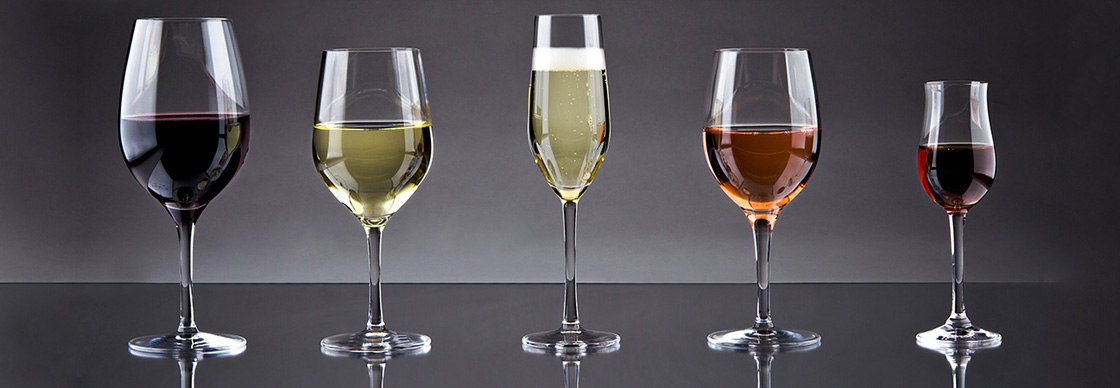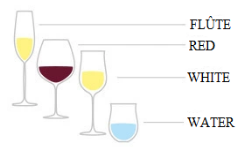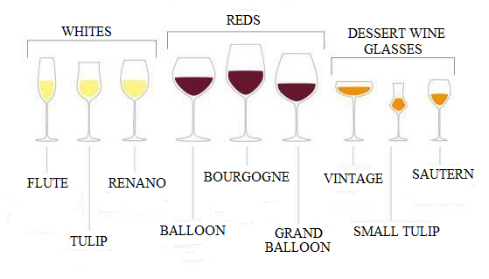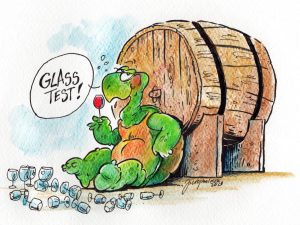
01 Apr A shape for each wine
Which wine glass should you use?
A glass is a tool that amalgamates our sensory organs and wine. Knowing how to choose the most suitable glass is quite important to both recognizing the characteristics of a wine more effectively and making the most of the tasting experience.
First of all, no coloured glasses! Every nuance of the wine must be clearly visible. All wine lovers know this. This is why a good wine glass must made be of either glass or crystal; it should be colourless and not too thick. The only exception can be made for dessert wines. In addition, the shape and size of the glass are fundamental elements for appreciating and enhancing the taste, the aroma and the colour of the wine. Of course, it must have a stem, which not only enhances the contents but also avoids touching the bowl and as a result altering its temperature!
Arrangement on the table

Types of wine glasses

With regard to brut, dry and demi-sec spumanti (sparkling wine), like prosecco, the classic flûte glass should be used; this glass enhances the perlage (the development of bubbles) and collects the subtle aromas. Instead, in order to best capture the complex nuances of more aged and mature classic methods, a slightly flared and bellied shape glass like the “Renano” should be used.
Young and fresh white wines are enhanced by a shorter and slightly rounded glass, with a light flare on the mouth, called “Tulip” reminiscent of the flower’s corolla. The flaring causes the wine to initially reach the tip of the tongue, where the sweetest sensations are perceived, and then move on to the side parts where, instead, the acidity is distinguished. There is also a slightly larger and bellied version of the “Tulip”, ideal for enhancing more important white, rosé or very young red wines such as a Novello.
A stem glass that is perfect for structured and barrique white wines is the “Renano“; round and broad to enhance the aromas and allow the wine to converge on the back part of the tongue. This glass actually goes quite well even with young reds or saignée rosé wines. The large belly helps oxygenation, while the narrow opening limits the aggressive tannins on the gums.
The “Ballon” is perfect for young and medium-bodied red wines. Its shape serves to oxygenate the beverage and release the most intense fruity aromas and freshness qualities. It can be used with a Chianti Classico. There’s also a larger version called the “Grand Ballon” which is perfect for very structured and very aged wines, to be savoured slowly, which continue decanting within this glass and release their intense aroma in the air. This is the perfect glass to savour our Pesanella 1990.
In fact, worth keeping in mind is that generally the more a wine ages and becomes complex, the more the glass becomes “bellied”. The glass’ larger size in fact softens the tannins and improves oxygenation, very important in this case to enhance the secondary aromas typical of aging.
For a full-bodied and structured wine, of medium aging, such as the Chianti Classico Riserva 2014, a Bourgogne should be used. In fact, its ample and elongated shape allows it to both oxygenate the wine perfectly and release its complex aromas.
Moving up in complexity, thus refining a bottled wine for years, we choose very large and tall glasses considered as small decanters, thus allowing the right oxygenation. The opening is long so as to enable the wine to immediately reach the back of the mouth, thus allowing the tertiary aromas to envelop the palate.
Let’s now move on to sweet wines.
The stem is shortened, the bowl remains broad while the top is rather narrow. The glass’ smaller dimension is directly proportional to the quantity of wine to be poured. What’s important, with regard to this type of glass, is to exalt the concentration of aromas on the nose and to allow the passage of wine quickly in the mouth so that the cloying sensation is not excessive.
The vintage glass is for aromatic and sweet sparkling wines because it is necessary to enhance the delicate floral scents and not the perlage of these wines. Its flared shape allows the more intense aromas to expand without overly “disturbing” the nose.
Finally, the ideal glasses for “meditation” wines, passito (raisin wine) or liqueur wines are the small tulip which serves to better concentrate the aromas and the Sauternes glass. The latter is specific for sweet “noble rot” wines such as, indeed, Sauternes.

Glass Test – by Jaro for Monterinaldi®


No Comments